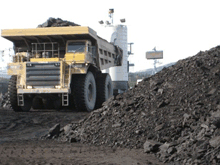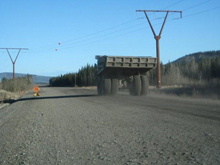 |
| UCM is the only operational coal mine in all of Alaska and needed effective video surveillance for dusty, harsh conditions |
Solution:
The viewing angles required were wide angle and made a perfect fit for high resolution/low light cameras. The Fluidmesh wireless mesh solution is scalable and highly re-configurable, and is rated for the most extreme conditions. The video quality proved far superior to the expectations of the owner which were based on traditional CCTV. Removing the complexity of the hard-wired approach allowed the integrator, ATS-Alaska, to go from a site visit to a working solution in an unprecedented two-week time frame. This would have been an impossible goal with a traditional system.
Project description at a glance:
Wireless mesh was a smart way to go, especially because the mine features a deep vertical underground shaft and a tall pole in the centre of the field. Both locations have a relatively clear line of sight to the new control room. A wireless mesh provided a very effective, non-trenching way to link the field cameras to the head-end, and Fluidmesh had the technology needed to tackle the infrastructure needs to a tee. The customer also had a tight schedule of operations that would not have lent well to trenching.
Using Fluidmesh technology and equipment in conjunction with Avigilon cameras, the system covers two sites. The first site is the vertical shaft of the mine where four Avigilon megapixel cameras are connected to the surface at ground level where the Fluidmesh 1100 wireless system is situated. The second site consists of a single explosion-proof PTZ camera equipped with an Avigilon encoder located at the top of a tall light pole and connected to another Fluidmesh 1100. Both sites are streamed live to the control room where a Fluidmesh 2200 is hardwired to an Avigilon NVR for recording and displaying.
 |
| Installation was pioneering as ATS had not worked on a coal mine project before using wireless mesh technology |
The dynamics inherent to this installation that make wireless mesh technology a good choice are long distance line of sight camera locations, harsh environmental conditions, and the constantly changing layout of the site. This install was pioneering in many ways, as ATS had not worked on a coal mine project before, and had very limited experience with wireless mesh technology. "Fluidmesh provided top-notch tech support," says Chris Ragula of ATS-Alaska.
"This is another important success story that we proudly add to our portfolio," notes Cosimo Malesci, Fluidmesh VP of Sales. "After extensive testing, Fluidmesh supports megapixel cameras encoding in MJPEG, MPEG4, and JPEG 2000 giving our customers maximum flexibility in their deployment and a smooth integration. The Fluidmesh proprietary transmission protocol allowed us to provide a bandwidth and a reliability much higher compared to an 802.11 based wireless system. In addition, the IP68/Nema6P rating of our mesh units make them a perfect fit for harsh environments such as coal mines, refineries, seaport, and chemical plants. Avigilon has been a great partner in megapixel technology due to the quality of their products and their tech support which aligns perfectly with Fluidmesh's philosophy."
Although the initial design required a combination of point-to-point and point-to-multipoint wireless connections for a high end Ethernet based CCTV system, Ragula says that for future expansion, there will be requirements for multiple wireless hops to transmit the video back to the head end. "Fluidmesh was a perfect fit for all the requirements," he adds.
The project flowed smoothly, as ATS was able to secure material for the project on a highly escalated timeframe. "We had product in our hands four days from the booking date," Ragula points out. "We had the site installed and operational within seven days of start of the project. The setup was very streamlined for both products and our technicians were able to figure out the new product in no time."
The end-user, Ragula reports, was immediately satisfied with the results and began plans for further expansion of the system. "We intend to visit the site in the coming months to re-locate one of the FM-1100's to accommodate a reconfiguration of the site. We plan to expand the system by eight or more cameras."





















